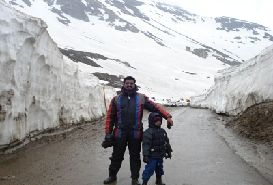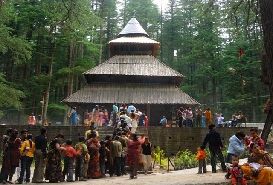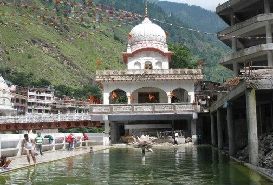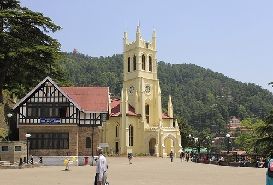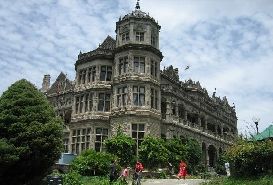Himachal Pradesh is popularly known as the ‘Abode of the Gods’ as it is home to numerous revered shrines. This majestic state houses a plethora of century-old monasteries and temples, which are flocked by many pilgrims throughout the year. Characterized by the beauty of the valleys, the Lahaul and Spiti district is home to the oldest Buddhist monasteries in Himachal Pradesh. This trans-Himalayan district is a popular destination for Buddhist pilgrims, scholars, and tourists. The splendid Gompas or monasteries have introduced a unique Buddhist culture here. In addition, the shrines of the valleys are known for their architecture and unique structural patterns.
Dharamshala, Kinnaur, and Kangra Valley are other places of Buddhist strongholds. Here, the ancient monasteries are a repository of Buddhist art, literature, and culture. The brilliant frescoes on the walls, tapestries, and painted murals are unique and worth checking out. Over the years, the Buddhist monasteries have gained prominence as training centers for lamas. Tibetan Buddhism is thriving in every corner of the country, and owing to the proximity of Tibet, these regions have a major Tibetan influence on them.
The monasteries of Himachal Pradesh are the perfect place to spend some quality time here and soak in the spiritual aura of these serene pilgrim sites. These monasteries should be on the top of the tourist bucket list during the Himachal Pradesh spiritual tour. These are the ideal places to get glimpses of the rich cultural heritage of Buddhism as well as to learn the preaching and teachings of Buddha.
Explore 3 Days Dharamshala tour package from chandigarh
Popular Monasteries in Himachal Pradesh
Boasts of rich splendor and a soulful atmosphere, the monasteries of Himachal Pradesh are among the most sought-after tourist destinations in India. These Buddhist religious centers are architectural marvels and spirituality. These are the perfect place for those seeking a peaceful experience in the beautiful destinations of Himachal. Have a look at the top monasteries in this charming state:
1. Key Monastery, Spiti Valley
Location – 17 km from the main Kaza town in Lahaul and Spiti district
Perched atop a hill at an altitude of 4,166 m above sea level, Key Monastery is over a thousand years old and dates back to 1100 AD. The monastery was founded by Dromton, a student of a famous teacher Atisha in the 11th century. It is popularly known for its architectural style, namely the Pasada style, characterized by two or more stories. Key Monastery spreads over three stories and looks like a fortress. This monastery has a long history of attacks and destruction due to invaders and natural calamities. It belongs to the Gelugpa Sect, also called the Yellow Hat sect of Tibetan Buddhism. Encompassed by snow-capped mountains and glaciers, Key Monastery offers an enchanting view of the Spiti River with the backdrop of quaint villages of the valley. Apart from the fascinating history and location, Key Monastery houses rare manuscripts, idols, instruments, ancient books, and a marvelous collection of weapons.
Facts – Key Monastery is the largest and oldest monastery in Lahaul and Spiti Valleys. It is a repository of rare Buddhist relics and literature. It is also home to around 300 lamas. The Thangka paintings here are of great interest to tourists.
2. Tabo Monastery, Spiti Valley
Location – 47 km from Kaza town
Popularly referred to as ‘Ajanta of the Himalayas, Tabo Monastery is snuggled at an altitude of 3,050 m above sea level in Spiti Valley. This historic site is known for ancient paintings, frescoes, thangkas, and murals. The monastery complex is declared as ‘National Historic Treasure of India’ by the Archeological Society of India. Nestled at the bottom of the valley, Tabo Monastery is India’s oldest continuously operating Buddhist Monastery. The most prominent feature of this monastery is that tourists can live within the walls of the Gompa and get glimpses of the lifestyle of monks. This monastery is a melting pot of Indian and Tibetan cultures.
Facts – This UNESCO World Heritage Site, built in the 10th century, houses 60 lamas. Check out the exquisite paintings, statues, nine temples, and the monk’s chamber.
3. Guru Ghantal Monastery, Lahaul Valley
Location – On the banks of River Chandra in the Lahaul and Spiti Valley
Founded by Guru Padmasambhava, Guru Ghantal Monastery is also known as Gandhola Monastery one of Lahaul Valley’s most popular attractions. Encompassed by mighty mountains and rolling sand dunes, Guru Ghantal Monastery is situated on the hilltop above Tupchilling Village at the confluence of Chandra and Bhaga Rivers. It was established in the 8th Century CE. Historians discovered the copper goblet in 1857, making it the oldest example of metalwork from the 1st century. In addition, this monastery houses some magnificent architectural specimens. Several clay idols within the monastery complex, including Guru Padmasambhava, Brijeshwari Devi, and other lamas.
Facts – The most exciting feature of this 800-year-old Gompa is the idols made of wood instead of clay. There is also a black stone image of the Hindu Goddess Kali in the interior chambers of the Gompa. This monastery is also famous as the Trilokinath Temple.
4. Dhankar Monastery, Spiti Valley
Location – 25 km from Kaza and 210 km from the hill station of Manali
Snuggled at an altitude of 3,894 m above sea level, Dhankar Monastery is among the most famous monasteries in Himachal Pradesh. It is listed as one of the hundred most endangered monuments in the world. This Gompa houses the collection of centuries-old thangkas, Buddhist murals, and scriptures. Dhankar Monastery is a fort-like structure built in the 16th century and consists of several multistoried buildings perched together. The monastery is in a fragile condition due to which more than 20 people are not allowed in the complex. The new Gompa has been built, which lures a large number of tourists. From the top of the monastery complex, tourists can witness the stunning landscape of the Spiti Valley.
Facts – This fascinating Gompa is home to around 150 monks. The Dhayan Buddha statue and the museum with Buddhist relics are the main attractions.
5. Namgyal Monastery, Mcleodganj
Location – 4 km from Dharamshala
Often referred to as Dalai Lama Temple, Namgyal Monastery is the largest Tibetan temple outside Tibet. It is considered the personal Gompa of the 14th Dalai Lama. The monastery’s foundation was laid down in the 16th century by the His Holiness 2nd Dalai Lama, Gedun Gyatso. It is also known as Namgyal Tantric College, which houses almost 200 monks who practice and learn various ritualistic traditions of Buddhism. Located amidst lush greenery and the snow-capped Himalayas, Namgyal Monastery is one of the best monasteries to visit in Himachal Pradesh with family and kids. It is located near several tourist destinations of Mcleodganj and Dharamshala, making it among the most sought-after tourist places in Himachal Pradesh.
Facts – Namgyal monastery is open only to the Buddhist spiritual leader, the Dalai Lama, monks, and students. All rituals from the major schools for Tibetan Buddhism are practiced here.
6. Kardang Gompa, Lahaul Valley
Location – Situated in Kardang village in Lahaul Valley
Belong to the Drukpa lineage, Kardang Monastery is a 900-year-old monastery situated in the foothills of the Himalayas. Nestled on the bank of the Bhaga River, this ancient monastery is located at an altitude of 3,500 m above sea level. This historical Gompa is a part of Kardang Village, the erstwhile capital of the Lahaul district. It is an important education center that comprises some of the finest collections of books of the bygone era. There is a 4-foot-long prayer hall in the monastery where the skull and ashes of Lama Norbu are preserved. Every year in June and July, the Cham dance organizes in the monastery, which is the major attraction of Kardang Monastery. The monks dressed in dramatic masks and headgear to perform various acts through dance, making it among the best Buddhist monasteries in Himachal. Tourists can see the fantastic collection of old weapons and instruments, including horns, flutes, drums, frescoes, paintings, and murals.
Facts – Kardang Gompa, which was renovated in 1912, has colorful wall frescoes and murals among its main attractions. In addition, the library has the largest volumes of Kangyur and Tangyur books of Buddhist scriptures written in the Bhoti language.
Check out Himachal pradesh tour packages, Solang Valley Tour Packages, Sarahan Tour Packages, Mandi Tour Packages
7. Palpung Sherbaling Monastery, Bir Billing
Location – Situated on Baijnath Bhattu Road and 8 km from Bir.
Nestled amidst the pine forest in the foothills of the Himalayas, Palpung Sherbaling Monastery is a famous religious center of Eastern Tibet. They offer Buddhist studies and the form of art of living, Buddhist meditation, and philosophy courses. This monastery complex comprises a school, college, and university where monks learn about the history of Buddhism. Almost 1200 monks study in these places. Tourists have to traverse through pine forests and tea plantations to reach there. The location of this monastery is a prominent feature, which makes it among the most charming Buddhist monasteries in Himachal to visit with families and kids.
Facts – The monastery has a massive complex where quarters are available for 250 monks, 3 shrine halls, 6 shrine rooms, and 4 retreat centers. In addition, there are shops and cafes where tourists can enjoy shopping and savor scrumptious meals.
8. Tso Pema Monastery, Rewalsar
Location – Rewalsar, 22 km from Mandi
Perched at an elevation of 1,360 m above sea level, Tso Pema is a lake that is a revered pilgrimage site among Hindus, Buddhists, and Sikhs. There are four monasteries situated on each corner of the lake, which are popular Gompas. The first monastery established in Rewalsar was Nyingma Gompa, which is located right at the lakefront. Drikung Kagya Monastery, Zigar Drukpa Kagyud Monastery, and Zangdok Palri Palace Monastery are the other three renowned Gompas of the region. According to the legends, Padmasambhava was burned here, and when the pyre was extinguished, the pond with a lotus on which Padmasambhava was seated due to which this place got its name Tso Pema means ‘Lotus Lake.’
Facts – Tso Pema is a square-shaped lake, which is also known as Rewalsar Lake. There are numerous caves in the region where Padmasambhava is believed to reside, and they are among the most popular pilgrimage site for Buddhists from all over the world.
9. Sakya Tangyud Monastery, Spiti Valley
Location – Komik Village, 2 km from Hikkim and 19 km from Kaza
Sakya Tangyud Monastery is one of the only two Sakya sect monasteries left in Spiti Valley. One is situated in Komik Village, and the other is located in Kaza. This monastery is settled at an altitude of 4,520 m above sea level and is one of the highest monasteries in the world. It is built on the edge of the deep canyon-like fortified castle-type structure and overlooks the town of Kaza. Located on the periphery of the Kibber National Park, Sakya Tangyud Monastery is locally referred to as Ancient Tangyud Monastery. As per the evidence, it was built in the 14th century when Sakyapas rose to power under Mongol patronage.
Facts – The oldest section of the monastery is the red building on the ridge, which comprises snow leopard hanging on its porch. Also, women are not permitted to enter the inner prayer hall.
10. Lhalung Monastery, Spiti Valley
Location – Tabo Kaza Road, Spiti Valley
Also known as Golden Temple, Lhalung Monastery is one of the oldest monasteries in Spiti Valley. Lhalung Devta is the head deity of the region. As per the legends, the color of the mountains encompassed the monastery varies as per the mood of the god. It becomes red when he is angry, blue when hurt, and yellow when happy. It is believed that this monastery evolved from the willow tree planted here in the 10th century. The same willow tree is still located in the monastery complex, which is been worshipped by the locals.
Facts – Till the 17th century, this monastery was a proper functional place where monks used to stay and study. However, afterward, due to severe natural calamity, the structure in the complex gets damaged except the main monastery building.
11. Shashur Monastery, Lahaul Valley
Location – Keylong, Lahaul Valley and located 72 km from Manali.
Encompassed by patches of blue pine, Shashur Gompa was founded in the 16th century by Lama Dewa Tyatsho of Zanskar. However, the monastery’s work was halted at that time, and later it was completed by Lama Dewa Gyatso. This shashur monastery is accessible by 3 km uphill walk from the main road of Keylong. This is a three-story structure and belongs to the Drukpa sect. The literal meaning of ‘Shashur’ is blue pine and complements the monastery’s name as blue pine trees surround it. This monastery is known for its incredible architecture, and it is decorated with beautiful paintings. In June and July, there is an annual festival organized here, which is the perfect way to get glimpses of the region’s rich cultural heritage and traditions.
Facts – The painting in the Shashur Monastery depicts the 84 Siddhas of Buddhism. The monastery complex also comprises a 5-meter tall Thangka, which consists of a beautiful painting with embroidery done all over it, and also, the complex houses a statue of Namgyal.
Check out Kullu Tour Packages, Kinnaur tour packages, Kasauli tour packages, Hamirpur tour packages, Dalhousie tour packages
Himachal Pradesh Tour Packages
Complete Himachal Tour
10 Nights / 11 DaysDelhi – Shimla - Kufri – Manali - Rohtang Pass - Dharamshala - Dalhousie - ChandigarhFrom ₹38,000 Per PersonFrom ₹28,000 Per PersonPrice On RequestShimla Manali Honeymoon Package
6 Nights / 7 DaysDelhi - Shimla - Kufri - Manali - Rohtang Pass - ChandigarhFrom ₹29,000 Per Person
Things To Do in Himachal Pradesh
Why Book With Us
35+
Years of Travel Experience
100+
Travel Experts To Assist You
03+
Million Satisfied Guests
Ministry
of Tourism Accredited
- 5/5 Rating:
- 4/5 Rating:







